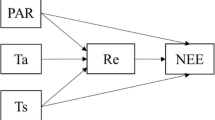Abstract
The majority of geostatistical estimation and simulation algorithms rely on a covariance model as the sole characteristic of the spatial distribution of the attribute under study. The limitation to a single covariance implicitly calls for a multivariate Gaussian model for either the attribute itself or for its normal scores transform. The Gaussian model could be justified on the basis that it is both analytically simple and it is a maximum entropy model, i.e., a model that minimizes unwarranted structural properties. As a consequence, the Gaussian model also maximizes spatial disorder (beyond the imposed covariance) which can cause flow simulation results performed on multiple stochastic images to be very similar; thus, the space of response uncertainty could be too narrow entailing a misleading sense of safety. The ability of the sole covariance to adequately describe spatial distributions for flow studies, and the assumption that maximum spatial disorder amounts to either no additional information or a safe prior hypothesis are questioned. This paper attempts to clarify the link between entropy and spatial disorder and to provide, through a detailed case study, an appreciation for the impact of entropy of prior random function models on the resulting response distributions.
Similar content being viewed by others
References
Christakos, G., 1990, A Bayesian/Maximum-Entropy View to the Spatial Estimation Problem: Math Geol., v. 22, n. 7, p. 763–777.
Deutsch, C., and Journel A., 1992, GSLIB: Geostatistical Software Library and User's Guide: Oxford University Press, New York.
ECLIPSE Reference Manual: Exploration Consultants Limited, Highlands Farm, Greys Road, Henley-on-Thames, Oxon, England, November 1984.
Jaynes, E., 1985, Entropy and Search Theory,in C. Smith and W. Gandy, Jr. (Eds.), Maximum Entropy and Bayesian Methods in Inverse Problems: Reidel, Dordrecht, Holland, p. 443–454.
Jaynes, E., 1985, Where Do We Go from Here?in C. Smith and W. Gandy, Jr. (Eds.), Maximum Entropy and Bayesian Methods in Inverse Problems: Reidel, Dordrecht, Holland, p. 21–58.
Jones, D., 1979, Elementary Information Theory: Clarendon Press, Oxford.
Journel, A., 1983, Non-Parametric Estimation of Spatial Distributions: Math. Geol., v. 15, n. 3, p. 445–468.
Journel, A., 1989, Fundamentals of Geostatistics in Five Lessons, Vol. 8. Short Course in Geology: American Geophysical Union, Washington, D. C.
Journel, A., and Alabert, F., 1989, Non-Gaussian Data Expansion in the Earth Sciences: Terra Nova, v. 1, p. 123–134.
Journel A., and Huijbregts, C. J., 1978, Mining Geostatistics: Academic Press, New York.
Kullback, S., 1968, Information Theory and Statistics: Dover, New York.
Marechal, A., 1984, Recovery Estimation: A Review of Models and Methods,in G. Verly et al. (Eds.), Geostatistics for Natural Resources Characterization: Reidel, Dordrecht, Holland, p. 385–420.
Scholle, P., and Spearing, D. (Eds.), 1982, Sandstone Depositional Environments: The American Association of Petroleum Geologists, Tulsa, Oklahoma.
Shannon, C., 1984, A Mathematical Theory of Communication: Bell System Tech. J., v. 27, p. 379–623.
Author information
Authors and Affiliations
Rights and permissions
About this article
Cite this article
Journel, A.G., Deutsch, C.V. Entropy and spatial disorder. Math Geol 25, 329–355 (1993). https://doi.org/10.1007/BF00901422
Received:
Accepted:
Issue Date:
DOI: https://doi.org/10.1007/BF00901422




